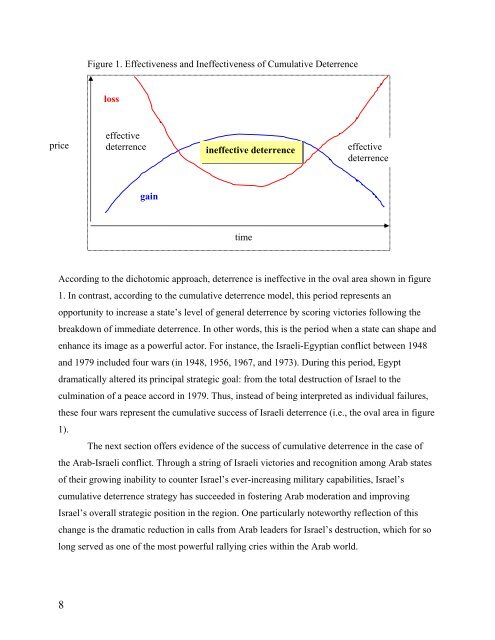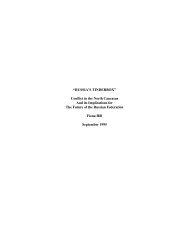Cumulative Deterrence and it's implementations to the War against ...
Cumulative Deterrence and it's implementations to the War against ...
Cumulative Deterrence and it's implementations to the War against ...
You also want an ePaper? Increase the reach of your titles
YUMPU automatically turns print PDFs into web optimized ePapers that Google loves.
Figure 1. Effectiveness <strong>and</strong> Ineffectiveness of <strong>Cumulative</strong> <strong>Deterrence</strong><br />
loss<br />
effective<br />
price deterrence ineffective deterrence<br />
gain<br />
time<br />
effective<br />
deterrence<br />
According <strong>to</strong> <strong>the</strong> dicho<strong>to</strong>mic approach, deterrence is ineffective in <strong>the</strong> oval area shown in figure<br />
1. In contrast, according <strong>to</strong> <strong>the</strong> cumulative deterrence model, this period represents an<br />
opportunity <strong>to</strong> increase a state’s level of general deterrence by scoring vic<strong>to</strong>ries following <strong>the</strong><br />
breakdown of immediate deterrence. In o<strong>the</strong>r words, this is <strong>the</strong> period when a state can shape <strong>and</strong><br />
enhance its image as a powerful ac<strong>to</strong>r. For instance, <strong>the</strong> Israeli-Egyptian conflict between 1948<br />
<strong>and</strong> 1979 included four wars (in 1948, 1956, 1967, <strong>and</strong> 1973). During this period, Egypt<br />
dramatically altered its principal strategic goal: from <strong>the</strong> <strong>to</strong>tal destruction of Israel <strong>to</strong> <strong>the</strong><br />
culmination of a peace accord in 1979. Thus, instead of being interpreted as individual failures,<br />
<strong>the</strong>se four wars represent <strong>the</strong> cumulative success of Israeli deterrence (i.e., <strong>the</strong> oval area in figure<br />
1).<br />
The next section offers evidence of <strong>the</strong> success of cumulative deterrence in <strong>the</strong> case of<br />
<strong>the</strong> Arab-Israeli conflict. Through a string of Israeli vic<strong>to</strong>ries <strong>and</strong> recognition among Arab states<br />
of <strong>the</strong>ir growing inability <strong>to</strong> counter Israel’s ever-increasing military capabilities, Israel’s<br />
cumulative deterrence strategy has succeeded in fostering Arab moderation <strong>and</strong> improving<br />
Israel’s overall strategic position in <strong>the</strong> region. One particularly noteworthy reflection of this<br />
change is <strong>the</strong> dramatic reduction in calls from Arab leaders for Israel’s destruction, which for so<br />
long served as one of <strong>the</strong> most powerful rallying cries within <strong>the</strong> Arab world.<br />
8
















